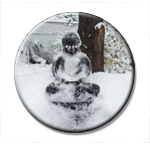On The Way: The Daily Zen Journal
Following the Breath with Mindfulness
Buddhadasa Bhikkhu (1906-1993)
The Buddha's Pranayama
It is essential that we understand this profound truth: the prana-body is the conditioner of the flesh-body. We ought to know that there are these two kaya (bodies), or levels of kaya. We know about the first level, the flesh-body, but we hardly know the prana-body at all. Therefore, it is very important to understand the prana-body, as it can condition the flesh-body in beneficial ways.
In India, the Pranayama is considered to be the highest and most important subjects for study. While different schools vary in their explanations and meanings for the prana-body, all schools seek to regulate the prana-body so that it conditions the flesh-body appropriately.

We need to study and train the breath in order to use it to condition the flesh-body. Since we cannot regulate the flesh-body directly, we regulate it indirectly. We study the prana-body and practice regulating it. By learning to regulate the prana-body, we regulate the flesh-body making it calm and peaceful.
We develop this knowledge through practice and training until we are able to regulate the prana. In this way we gradually develop a good, healthy body that is ready for concentrating the citta (mind, heart, consciousness). Both the body and mind are prepared to do their respective duties.
Before the Buddha’s time people practiced many types of Pranayama. When the Buddha appeared, he too practiced Pranayama; he then incorporated it into this system of contemplating the breath. And through this system of contemplating the breath, we regulate life and the body.
Finally, we come to noting, contemplating, our breathing. In order to begin, we must develop sati (mindfulness or reflective awareness) by being mindful of each in-breath and out-breath. We train in sati by noting that we are about to breathe in or breathe out. Let the breathing continue comfortably and normally. Let it be natural. Do not interfere with it in any way. Then contemplate each breath with mindfulness. How are we breathing in? What is the out-breath like? Use sati to note the ordinary breath.
We first develop and train sati by using a technique called “following,” or “chasing.” We imagine the in-breath starting from the tip of the nose and ending at the navel. We imagine our out-breath starting at the navel and ending at the tip of the nose. In between these two points is the space through which the breath runs in and out. We contemplate with sati the properties of this movement in and out, from the tip of the nose to the navel and back again. Back and forth. Do not allow any gaps or lapses. This is the first lesson: contemplate the breath with sati.
Even though we are not medical students, we still know that the breath only goes into the lungs, that it does not go all the way down to the navel. Imagining that the breath ends at the navel is merely a useful convention; we do not hold it to be true. It is just an assumption based on our feeling and sensitivity of the movement of the breathing. When we breathe, we feel movement all the way down to the navel. We use that feeling as the basis of our practice and follow the breath between the tip of the nose and the navel.
The distinction as to whether it is sati that follows the breath in and out or whether sati forces the mind to follow the breath in and out is not important at this point. All that matters is to contemplate the breath as if chasing it, without ever losing it. The breath goes in and stops a moment. Then it comes out and pauses a moment. In and out, in and out, with short breaks in between. We must note everything and not let anything slip by. We do not allow empty spaces where the mind might wander but keep the mind constantly focused on breathing in and out.
This is the first lesson to learn, the foundation for all the rest. It may not be so easy. Maybe it will take three days, three weeks, or three months until we are able to do it. This is the first step, the first task we must accomplish. Here we are merely explaining the method of training; it is the practice that counts.
You may not get very far in a ten day course at Suan Mokkh or some other meditation center, but it is important to know what needs to be done and to get started doing it. Once you correctly understand the method, you can practice on your own until you are successful. So begin with this simple step: contemplate the breath as it moves between the nose and the navel without leaving any chances for the mind to wander elsewhere.

Many Kinds of Breath
As we practice “following,” we have the opportunity to observe the various characteristics of the breath. For example, we can feel the long and the short duration of the breath. Thus, we learn naturally about the long breath and short breath. We can observe the coarse and fine nature of the breath. Further, we can observe its smoothness and bumpiness. Later we will observe the reactions to these qualities. In this first step, however, we contemplate the different kinds of breath; long and short, coarse and fine, easy and uneasy. Begin to observe the various kinds by experiencing them with sati.
We must learn to observe in greater detail, that is, to observe the reaction or influence of each different kind of breathing. What reactions do they cause? How do they influence our awareness? For example, when each breath is long how does this affect our awareness?
What reactions do short breaths cause? What are the influences of coarse and fine breathing, of comfortable and uncomfortable breathing? We should observe the different types of breath and their various influences until we can distinguish clearly how the long and the short breaths, coarse and fine breaths, and comfortable and uncomfortable breaths differ. We must learn to know the reactions to these various properties of the breath. Likewise, we must learn to know when these qualities influence our awareness, our sensitivity, our mind.
It is also important for us to note the effect or flavor of each kind of breath. The flavors that arise as different kinds of feeling are: happiness, unhappiness, dukkha (suffering), annoyance, and contentment. We observe and experience these flavors or effects caused by the long breath and the short breath, by the coarse breath and the fine breath, and by the easy breath and the uneasy breath.
Find out why they have different flavors. For instance, we can see that the long breath gives a greater sense of peace and well-being; it has a happier taste than the short breath. Different kinds of breath bring different kinds of happiness. We learn to analyze and distinguish the various flavors that characterize the different kinds of breathing we have scrutinized.
Finally we can discover the various causes that render our breathing either long or short. We gradually learn this by ourselves. What causes the breathing to be long? What kind of mood makes the breath long? What kind of mood makes the breath short? Thus, we also come to know the causes and conditions that make the breath long or short.
There is a method that we can use to regulate the breath in these beginning steps to make it longer or shorter. This technique is called “counting,” and it trains us to change the length of our breathing. For example, as we inhale, we count from one to five. If during one breath we count at the same pace but from one to ten, that breath will lengthen accordingly.
During an ordinary breath we only count to five. For a short breath we might count to three and that shortens the breath as we wish. We should always count at the same speed, for if we change the pace of counting, it will negate the effect of counting higher or lower. By counting, we can regulate the duration of each breath. By using this special training technique we can lengthen or shorten the breath. We do not have to use it all the time, but we can employ it occasionally to help us regulate the breath or to get to know it better. We can give it a try whenever we choose.
Buddhadasa Bhikkhu (1906-1993)
Source: Mindfulness with Breathing – A Manual for Serious Beginners trans by Santikaro Bhiddhu 1988





Every day we begin with basics, awakening, breathing, and attending to the needs of the body. Every day is a new opportunity to practice meditation and in each action of daily life.
No matter how many years we have practiced, or if we are just discovering a way to practice, we can maintain beginner’s mind. Beginner’s mind is that state before we know too much, before we can explain principles to anyone else, where everything is fresh and unexplored and full of wonder.
Yesterday we didn’t know about this movement or focus on breathing or the ability to perceive without any preconceived notions. It is all just new to us. We learn the introduction to meditation through breath counting and often feel like that is just for beginners, then we advance to just watching the breath, and sometimes we think we have progressed beyond all this need for breath awareness.
The beauty of breath practice is that it allows universal application; there is not one situation where we can’t incorporate awareness of breath. Following the breath brings us skillfully into the present and allows the awareness to become focused and the body to become calm. So each time we return to the breath, we are returning to the beginning once again. Meditation can happen anywhere when we can return to each breath.
Returning to the beginning together,
Elana, Scribe for Daily Zen